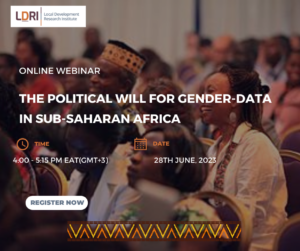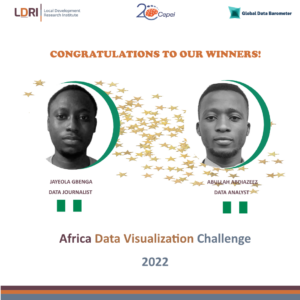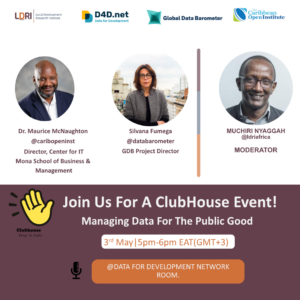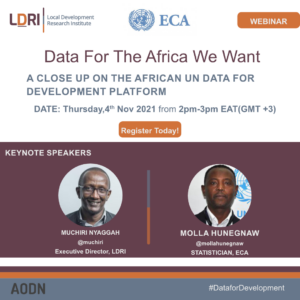![]()
Making Data for Development work: Exploring Drivers for Development Data in Kenya
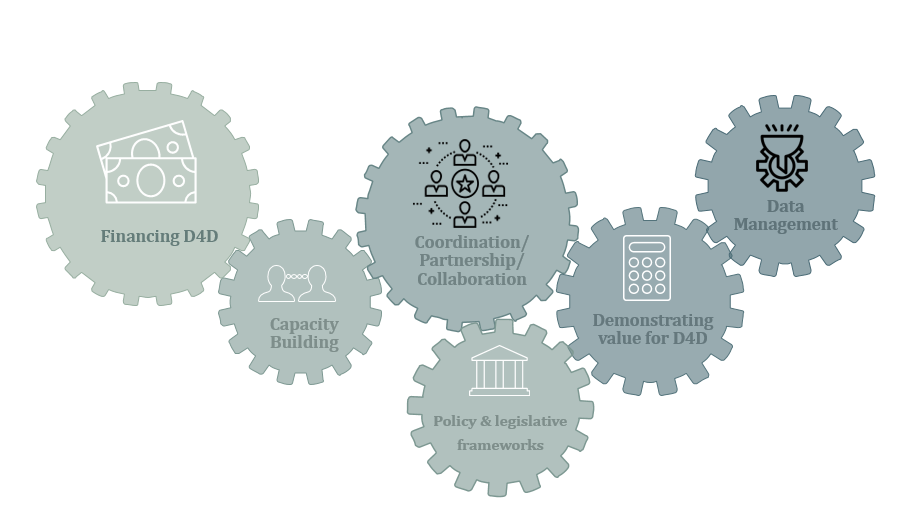
 As part of our work with the Africa Open Data Fellowship Program under the Africa Open Data Network we’re conducting a study on the drivers for success for data for development (D4D) initiatives in Africa. The study seeks to identify human capital, financing, enabling environment and infrastructure needs for sustainable and mainstreamed data for development initiatives. While cross sector data is necessary for sustainable development, the program prioritizes data on Agriculture, Health, Education, Public Finance and Public Contracting with cross-cutting focus on gender and innovation. This blog post is part of a series of blogs exploring the idea of data for development and sharing insights from across different African countries. This first post presents initial findings from the study in Kenya.
As part of our work with the Africa Open Data Fellowship Program under the Africa Open Data Network we’re conducting a study on the drivers for success for data for development (D4D) initiatives in Africa. The study seeks to identify human capital, financing, enabling environment and infrastructure needs for sustainable and mainstreamed data for development initiatives. While cross sector data is necessary for sustainable development, the program prioritizes data on Agriculture, Health, Education, Public Finance and Public Contracting with cross-cutting focus on gender and innovation. This blog post is part of a series of blogs exploring the idea of data for development and sharing insights from across different African countries. This first post presents initial findings from the study in Kenya.
Data for development (D4D) can be broadly understood as harnessing data from both conventional and new sources to better inform decision-making and enable sustainable development. With the data revolution gaining momentum on the African continent, it offers a chance to mobilize data production and use towards the realization of targets set out in Africa’s normative development blueprints and global targets such as Agenda 2063 and the Sustainable Development Goals(SDGs) respectively.
For Kenya, the Kenya National Bureau of Statistics (KNBS) is Kenya’s primary provider and custodian of official statistics. However, the conversations on data for development in Kenya have been articulated majorly within the context of Kenya Open Data Initiative (KODI). The initiative saw the launch of Sub-Saharan Africa’s first government open data portal launched in 2011. KODI’s goal is to provide open data to the public across different sectors. This initiative is anchored in the 2010 Kenyan Constitution and articulated in The Access to Information Act, 2016 that requires government to make information (data included) available to citizens.
KODI is among the D4D initiatives taking shape in Kenya, implemented by both government and non-state actors with the most recent aspect being the push to use geospatial data to address especially agriculture, deforestation, and water access. The increase in the number of D4D initiatives however, does not signal the optimal use of data to drive development. Even as new technology provides a wider variety of ways to generate and use data, data deprivation still exists and lack of use of existing data in some cases. It is therefore worth exploring what it would take to maximize impact and better outcomes for D4D. From our initial study in Kenya, we identified 6 key drivers that would enable the implementation of successful D4D interventions.
Drivers for D4D in Kenya
Coordination/Collaboration
With the breadth of data required to deliver on development commitments by countries, greater collaboration, coordination, harmonization and integration of data initiatives is essential. What should however foreground collaboration is an alignment of a potential data roadmap with national development blueprints/priorities. Having a data roadmap that corresponds to Vision 2030, Medium Term Plan III, county development plans and priorities of the government of the day such as the Big 4 Agenda, ensures that data is integrated into the day-to-day activities of those implementing development agendas and that external funding for D4D initiatives feeds into this.
Creating collaborations between data actors within and outside of government, tapping into multiple dynamic and growing data communities such as the growing big data and open data communities in Kenya and getting government to work more closely with other data actors are potential ways of making collaboration better. A problem area for collaboration is getting data collected by non-state actors accepted into the NSS which could be addressed through a consensus by stakeholders on methodology and scale that would guide non state actors generating data.
Capacity building
Unequal data capacity to drive development hampers how data can be harnessed to deliver development objectives. Gaps exist in the technical skills required to manage, analyze, disseminate, and communicate data and questions linger on the availability of sustainable local capacity and expertise to enable home-grown D4D innovations and solutions. There also are a few reservations especially at the grassroots regarding the uptake of technological tools which make it difficult for tech anchored D4D interventions to take root.
A lot of work therefore still needs to be done to address the existing technical skills gap and unequal data capacities within different government ministries/agencies and to build sustainable local capacity both from the top and the bottom. An important part about this is changing perceptions about data and making it central to development work. It can also not be understated that capacity building has to be done on both supply and demand sides to trigger better uptake of already existing data.
Demonstration of the value of data
Demonstrating the value of data within and beyond the capital city to the devolved units can motivate investment in the production and use of good quality data, innovation, scale ups and the replication of interventions. Possible ways of going about this are going beyond tech/innovation hubs to link data to relatable grassroots issues, enhancing communications on the impact of data used to support development processes and demonstrating the economic value of D4D. Open Schools Kenya is one such intervention whose value has been seen by stakeholders and has since been replicated in different localities.
Data management
Proper data management throughout the data’s life cycle holds the key to successful D4D interventions. Accessibility and the utility of data are the missing links between data’s existence (in whichever formats) and its use for development. This disconnect can be attributed to massive data gaps in management (collection, storage, analysis and openness/sharing), lack of effective governance frameworks related to the production, processing, protection, ownership, quality, openness, timeliness, relevance, accessibility, harmonization, interoperability and use of different types of data, regardless of who produces or owns them and lack of standard metrics across different administrative units.
These could possibly be addressed through standardization of data collection and analysis templates across different administrative units, formulation of a policy that addresses data processing and ownership and engagement with other stakeholders for better data consumption by all players especially through translating data to the grassroots level.
Financing data for development
Significant financial investment in statistical capacity makes it possible for D4D to thrive. Developing sustainable financing models for D4D programs and interventions, dedicating a budget line to the National Statistical System(NSS) would help ensure consistent funding for D4D. Additionally, matching the funding with where there is the greatest need or where there is potential for more impact such as administrative statistics would ensure the available funding addresses most pressing issues.
Monetization of data also provides an avenue to raise more money for D4D initiatives. It is however important to note that monetization of ‘core data’ negates the spirit of open data and as such monetization of products created from adding significant value to the ‘core data’ is recommended.
Supportive Policy and Legislative Frameworks
The presence of laws and policies allowing people free access, use and reuse of data are imperative to enable people to harness the data revolution. The African Union Strategy for the Harmonization of Statistics in Africa (SHaSA) is one such document. However, impediments such as government agencies having policy documents that are at cross purposes with each other, lack of adherence to existing policies and having the institutional structures that support policy frameworks corresponding to political/election cycles makes it difficult for this to happen.
Possible ways to mitigate these include generating evidence of incoherence, conflict and inadequacies in law and policy and packaging it in a way that influences change, leveraging international partnerships to help hold the government accountable and ensure compliance to the agreements they are part of, evidence based advocacy, lobbying and awareness creation on the need for policies, and the establishment of a data sharing standard/framework. Other legal and policy provisions identified as being central to enabling D4D include policies on privacy and data protection such as the proposed The Data Protection Bill, 2018 which is yet to become law and a potential open data policy to institutionalize data and data sharing.
Who are the stakeholders in the Data for Development ecosystem in Kenya?
The D4D ecosystem in Kenya brings together multiple stakeholders, the major one being government, both national and county. The additional players instrumental in making sustainable D4D initiatives work broadly are development partners, Civil Society Organizations, media, academia (individuals and institutions) and the private sector. While traditionally the roles of government, development partners and CSOs have been clear, the role of the media has only recently been apparent with more focus on data journalism. There is however still a lot of work to do in engaging academic institutions in the ecosystem and articulating their progressive role in the chain.
More specifically, the D4D ecosystem in Kenya has been characterized by individual champions for specific issues related to D4D as opposed to institutionalized ways of working. Champions are an important part of furthering the conversation, but combining this with institutionalized approaches to D4D provide a more sustainable way of implementing it.
Finally, it is also important to anticipate how external factors could potentially affect D4D within the country and find ways to mitigate them. Change of donor priorities for instance is an issue that may slow down D4D within the country if the bulk on initiatives rely on donor funding.

